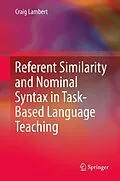This volume addresses an important gap in the literature on task design and second language use. Building on insights from over 50 years of research on the relationship between task demands and language use, it examines how referent similarity relates to developmentally-relevant variation in the use of nominal structures, comparative structures and abstract lexis among first and second language speakers of English. In addition to providing an empirical basis for future research on tasks, it shares both theoretical and practical information on task design, which will greatly benefit curriculum and material developers.
Autorentext
Craig Lambert is an Associate Professor of Applied Linguistics and TESOL at Curtin University in Perth, Australia. He has taught in post-graduate TESOL programs at Anaheim University in the United States and at Lancaster University in the United Kingdom, and has more than 20 years of hands-on teaching experience in Japan, where he worked as an English teacher, course coordinator and teacher trainer. His research on second language speech processing, syntactic development, task-based learning and learner engagement has been published internationally.
Inhalt
Acknowledgments
Table of Contents
List of Tables
Chapter 1. Introduction
1.1.Tasks in Language Teaching and Research
1.2.Task-Based Language Teaching (TBLT)
1.3.Task Learning versus Language Learning
1.4. Referent Similarity and TBLT
1.5. Overview of the Book
2.1. Language Development from a Usage-Based Perspective
2.2. Frequency Effects
2.2.1. Cue Strength
2.2.2. Prototype Effects
2.2.3. Chunking
2.3. Syntactic Priming
2.4. Transferability
2.5. First and Second Language Acquisition
2.6. Summary
Chapter 3. Referential Communication and L2 Production
3.1. Referential Communication Tasks
3.2. Communicative Demands
3.3. Contextual Constraints
3.4. Discourse Demands
3.5. Limitations of Tasks in Instructed SLA
3.6. Proficiency and L2 Performance
3.7. Summary
Chapter 4. Tasks in L2 Syllabus Design
4.1. Attention
4.1.1. Detection
4.1.2. Awareness4.1.3. The Output Hypothesis
4.1.4. Resources Pools
4.1.5. Selection (Saliency, Effort, Expectancy & Value)
4.2. Speech Production
4.3. Cognitive Processes in SLA
4.3.1. Analysis
4.3.2. Control
4.4. Cognitive Models of Task-Based L2 Instruction
4.4.1. The Limited Attention Capacity Hypothesis
4.4.2. The Cognition Hypothesis
4.5. SummaryChapter 5. Referent Similarity
5.1. Referent Identification
5.1.1. Frequency
5.1.2. Comparison
5.2. The Number of Elements5.3. The Similarity between Elements
5.4. The Present Study
5.5. Summary
Chapter 6. Referent Similarity and L2 Production
6.1. Noun Phrase Complexity
6.2. Comparative Structures
6.3. Relative Clause Structures
6.4. Lexical Abstractness
6.5. Summary
Chapter 7. Methods
7.1. Purpose of the Study
7.2. Design
7.3. Participants
7.3.1. Native Speakers of English
7.3.2. Non-Native Speakers of English
7.4. Materials
7.5. Procedures
7.6. Analysis
7.6.1. Transcription
7.6.2. Noun Phrase Coding
7.6.3. Comparative Structures
7.6.4. Relative Clause Types
7.6.5. Statistical Analyses
7.7. Summary
Chapter 8. Results
8.1. Preliminary Data Screening
8.1.1. Descriptive Statistics for Similarity Effect on NP Complexity
8.1.2. Descriptive Statistics for Referent Effect on NP Complexity
8.1.3. Descriptive Statistics for Proficiency Effect on NP Complexity
8.2. Three-Way MANOVA on Noun Phrase Complexity
8.2.1. Referent Similarity Effects on Noun Phrase Complexity
8.2.2. Referent Effects on Noun Phrase Complexity
8.2.3. Proficiency Effects on Noun Phrase Complexity
8.2.4. Interactions between Factors on Noun Phrase Complexity
8.2.5. Summary of Noun Phrase Complexity Results
8.3. Two-Way ANOVA for Use of Comparative Structures
8.3.1. Referent Similarity Effects on the Use of Comparative Structures
8.3.2. Referent Effects on the Use of Comparative Structures
8.3.3. Proficiency Effects on the Use of Comparative Structures
8.3.4. Summary of Results for Comparative Structures
8.4. Non-Parametric Tests for Us...
Titel
Referent Similarity and Nominal Syntax in Task-Based Language Teaching
Autor
EAN
9789811330896
Format
E-Book (pdf)
Hersteller
Veröffentlichung
07.12.2018
Digitaler Kopierschutz
Wasserzeichen
Dateigrösse
2.37 MB
Anzahl Seiten
154
Unerwartete Verzögerung
Ups, ein Fehler ist aufgetreten. Bitte versuchen Sie es später noch einmal.
